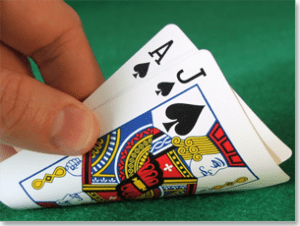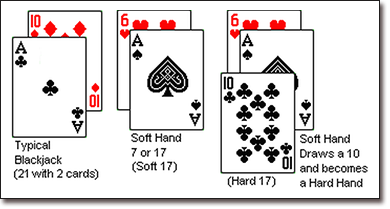In this article, we will walk you through all the basic rules of blackjack. Then, once you have a firm understanding of how the game works, we’ll explain the rule variations you’re likely to encounter in casinos across Australia.
Featured Casinos
Ask any random stranger about blackjack rules, and they’re likely to say “you have to get as close to 21 as possible without going over.” While this statement is true, the laws governing the game of blackjack are a bit more complex. Luckily, any player with a decent attention span should be able to learn them within a short period of time.
Best Web casinos to play blackjack
Our top online casinos to learn and play Internet blackjack are:
1/ All Slots Casino
2/ G’day Casino
3/ Guts Casino
4/ Royal Vegas Casino
5/ Jackpot City Casino
All five sites offer free and real money blackjack, so players can practice and learn the rules at their own comfort and pace before playing with real cash. If playing on multiple platforms is your thing, you’ll be glad to know all sites offer their games as playable on computer, laptop, mobile and tablets.
How to play blackjack

The game of blackjack begins with between one and eight decks of card being shuffled by the dealer. Face cards are valued at 10, aces are worth one or 11 (up to the player and can change during the hand), and all other cards are worth their face value.
Each player is then allowed to place an initial wager. After bets have been made, the dealer deals two cards face up to each player (starting on his left). The dealer receives only one face up card, although in games outside of Europe and Australia the dealer will also receive a face down card (known as the ‘hole card’).
Our goal is to accumulate cards as close to 21 as possible, while still exceeding the total of the dealer’s hand. If the player’s total exceeds 21, then he/she busts (loses the hand and bet).
Once the cards have been dealt, each player will take turns informing the dealer what they wish to do with their hand. These are the available options players have:
Hit – Adding another card to their hand. You can hit as many times as you wish, but once you go over 21, you lose.
Stand – Choosing not to take any additional cards and remain on the total of whatever your cards show.
Split – If the first two cards have the same value, the player can choose to split them. These cards form two separate hands and receive another card each. An additional bet must be made to accompany the second hand and then both are played out as normal.
Double Down – The player may choose to double their original wager and in return, they receive only one additional card. If your cards total 10 or 11, this is often a popular bet because you have a good chance of hitting a card valued at 10 to take you to either 20 or 21.
Surrender – The player has the option of surrendering their hand instead of playing it out. The penalty for surrender is the loss of half of the player’s initial wager.
Insurance – If the dealer’s card is an ace, the player may choose to purchase insurance against a potential dealer blackjack. The size of the wager can be up to half of the player’s original bet. If the dealer does hit blackjack, this bet pays at 2:1. If not, the player loses any chips wagered as insurance.
Once all players have finished playing, the dealer draws his/her second card (or reveals the ‘hole card’). The value of each hand is added up, and anyone who beat the dealer’s total receives the appropriate payout.
A blackjack is achieved when the first two cards of a hand are an ace, and a card valued at ten (a 10 or a face card). Rules vary in different casinos, but often a player who hits blackjack is immediately paid out regardless of what the dealer ends with. In some other cases, if the dealer also hits blackjack, it is considered a ‘push,’ (no one wins or loses). It is impossible to lose with a hand of blackjack and it will always beat any other hand the dealer may end up with (including a total of 21 which is not gained via blackjack).
Practice Blackjack at All Slots CasinoRule variations for blackjack
The above section covered the standard rules of blackjack that are common to casinos around the world. The following section deals with rule variations, which can vary wildly from one establishment to another.
Dealer wins on a tie – This variation is rarely used in traditional blackjack. When it does occur, the player push is changed to a loss.
Payout alteration on blackjack – The normal payout for blackjack is 3:2, although some rules will alter this to pay out 6:5 or even 1:1. This rule variant has a major impact on the house edge, and not to the advantage of the player.
Double down restrictions – Known as the “Reno Rule,” this variant of the blackjack rules limits doubling down to hard totals of 9 through 11. In certain European casinos, it’s further limited to just 10 or 11
 Soft 17 rule – Some casinos require the dealer to hit on a soft 17, while others will make the dealer stand under these circumstances. The stand option is beneficial to the player, lowering the house edge by a small amount.
Soft 17 rule – Some casinos require the dealer to hit on a soft 17, while others will make the dealer stand under these circumstances. The stand option is beneficial to the player, lowering the house edge by a small amount.
Hitting and re-splitting split aces – Normally, split aces are limited to one additional card each. However, there are some rules which allow players to hit split aces or even re-split them.
Re-splitting – If you split cards and the new hands contain cards of the same value, resplitting allows you to split the hands once again. Most casinos limit the number of resplits to a total of four hands, while others allow unlimited resplitting.
Original bets only – Also known as “OBO,” this rule variant applies to games where the dealer doesn’t have a hole card. If the player loses to a dealer blackjack, only the initial wager is lost. Any bet made via splitting and doubling is considered a push.
Number of decks – Casinos normally use one, two, four, six, or eight decks. The more decks in play, the greater the advantage for the house (0.17% for a single deck versus 0.65% for eight decks). If the casino users fewer decks, it’s common for them to alter rules to compensate for the player advantage.
No hole card – The dealer doesn’t take a second card until all players have completed their hands. This adds to the house edge.
Surrender – Late surrender is offered when the dealer’s first card is an ace or ten (but only after the hole card has been checked for blackjack). Early surrender is available before the dealer checks for blackjack. If you have the option and all other rules are equal (they probably won’t be), always choose the early surrender option.
No doubling after the split – The player is normally allowed to double down after a split. If this is prohibited, the house edge gets a small bump.
Blackjack rules are easy to understand, even though the element of chance still makes it an impossible game to master. While newcomers tend to become frustrated during the early stages of their development, patience and persistence (combined with basic strategy) should ensure that the dreaded house edge is slowly whittled away. It won’t go away completely, but dedicated players can put a respectable dent in it.
